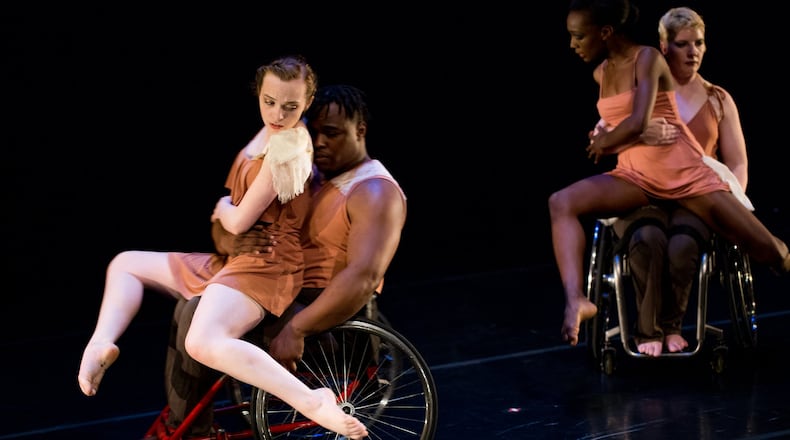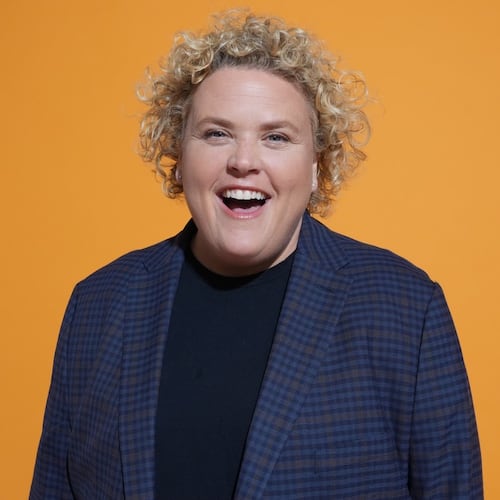Story by Pamela A. Keene. Photos by Jenni Girtman
Soon after they met in the late 1990s, Lindy Dannelley and Laurel Lawson built a friendship on their shared love of theater, music and performance.
Both had performed on stage since they were young. Dannelley pursued a career in theater management and worked for many years with such Atlanta companies as Stage Door Players. Lawson trained as an actress, flautist, classical singer and pianist.
“When I was growing up, little girls in wheelchairs didn’t go to ballet class,” says Lawson, who was born with a disability. Instead, she pursued music and sports, including wheelchair basketball.
After Dannelley was diagnosed with sacroiliac joint dysfunction in the early 2000s, Lawson kept by her side. The friendship led Dannelley to Full Radius Dance, a professional company based in Atlanta for dancers with and without disabilities who perform around the world.
“I went to see Laurel perform with Full Radius Dance and I was floored,” Dannelley says. “I realized that there was so much more that I could do, so I started going to the Full Radius Dance Fridays, which was open to anyone who wanted to learn to dance. I had always loved dance, but once I was using a wheelchair, I hadn’t imagined that I could. Boy, was I wrong.”
She was offered an apprenticeship and has now been a member of the professional company for more than eight years.
Founder, choreographer and executive director of Full Radius Dance, Douglas Scott earned his Bachelor of Fine Arts in theater and dance from Western Kentucky University. He was lured to Atlanta in 1984 by an article in Southern Living magazine that described the city as “the New York of the South.” He danced with several professional organizations, including Ruth Mitchell Dance Company, before starting his own.
Originally called Dance Force Inc. in 1990 and featuring performers without disabilities, the company transitioned to Full Radius Dance in 1998 to provide a platform for a diverse group of dancers to perform professionally in a physically integrated environment.
“I attended a workshop led by Cleveland’s Dancing Wheels, the country’s oldest continuously working company focusing on physically integrated dance for dancers with and without disabilities,” Scott says. “Following that, I was fortunate enough to be chosen by VSA Arts of Georgia to train with two other dancers to teach physically integrated dance here in Atlanta. At the end of a year, I was the only teacher left.”
Scott found his sense of mission. “My eyes were opened, and I knew that we needed to create a professional dance company and to provide training for whoever wanted to come into the studio, regardless of their physical abilities. And I realized that just because a dancer’s body doesn’t look or move like mine, that doesn’t negate their artistic technique,” he says. “Our work is predicated on understanding disability as part of human diversity and in physically integrated dance as an art form that celebrates the equal use of dancers with and without disabilities.”
“When people hear about us, they think that we just push each other around or be pushed by other dancers on stage, but that’s not the case at all,” Dannelley says. The dancers with disabilities study specific techniques such as wheelies, spins, one-wheel stands and other movements, sometimes supported by the dancers without disabilities and sometimes alone.
For instance, the piece “So, Do You Know What You’re Doing Now” premiered in the 2016-17 season and has been staged in various locations, including New York and Atlanta. Six dancers — three with disabilities and three without — perform partner lifts and spins, leaps, and other movements to a blend of contemporary music.
“Once you’ve watched our performance for a bit, most people become immersed in the choreography and are able to move beyond their preconceptions about disability,” Dannelley says.
The professional company varies from six to nine dancers, depending on the works being performed. While many of the dancers with disabilities use wheelchairs, other dancers have performed using crutches, prosthetics or power chairs.
Lawson says that time on stage is a small part of the commitment of the dancers. “That moment on stage is about 1 percent of what we do,” she says. “It’s really about time in the studio, practice, training and discipline.”
In addition to rehearsals, dancers must be in good physical shape. “We go to other dance classes and have our own personal workouts,” Dannelley says. “I also swim regularly, and I get to the pool along a 4-mile wheelchair-accessible track from my home. Just like any other dancers, we need to be at peak fitness.”
The work combines dance technique, discipline and teamwork. “We couldn’t do this if we didn’t have that level of trust,” says Lawson, who has danced with Full Radius for 14 years and is the company’s senior company dancer. “It’s highly collaborative between the dancers and the choreographer.”
Full Radius Dance performs at venues including Atlanta’s Modern Dance Festival in May, international events, school groups and symposia, ranging from rural Georgia to Seoul, Korea.
“We still face skepticism from people who hear about us,” Scott says. “But once they see our performances, it’s all about dancers, the passion, the creativity and the dance. It’s been such a joy to work with this talented company and help open people’s eyes to the possibilities.”
Dannelley is quick to point out that perceptions of frailty or helplessness are far from the truth. “Whether I’m in the grocery store doing my own shopping or throwing a full-sized human being over my lap in a performance, I can do what I set my mind to and it is the most fulfilling thing.”
Insider tip
Full Radius Dance welcomes participation in classes and workshops. The group's Summer Intensive offers the opportunity to learn about Full Radius Dance Technique, physically integrated dance, choreography and teaching, plus partnering. The dates for the 2018 Summer Intensive are Aug. 12-18; space is limited. fullradiusdance.org
About the Author
The Latest
Featured

